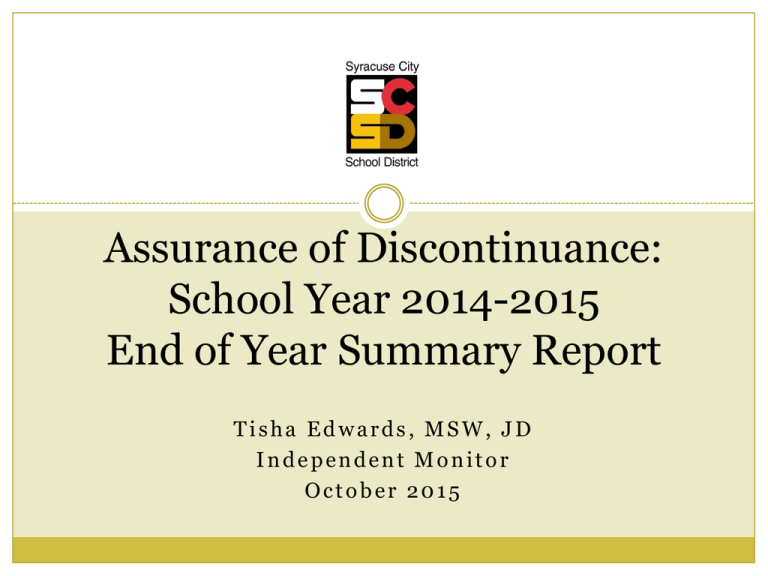Assurance of Discontinuance: School Year 2014-2015 End of Year Summary Report
advertisement

Assurance of Discontinuance: School Year 2014-2015 End of Year Summary Report Tisha Edwards, MSW, JD Independent Monitor October 2015 AOD #33-36: Designation of Internal Ombudsman 2 SY14/15 Progress: The District has budgeted a total of twelve new positions to support the implementations of the Assurance. As of October, two positions remain vacant—the Director of School Culture & Climate and the Chief Ombuds Officer. Recommendation: The District should take aggressive steps to recruit and retain a Chief Ombuds Officer replacement to maintain momentum as it enters into the second year of the Assurance. A focus area for the upcoming school year is to more comprehensively monitor the Assurance provisions that impact school-level discipline practices. The two positions that are currently vacant are important to improving school-based efforts including providing guidance and support for the School Improvement Teams and School Discipline Committees, implementing alternatives to discipline, and ensuring due process for shortterm suspensions. AOD #40-42: Due Process Safeguards 3 SY14/15 Progress: In SY12/13 and SY13/14, the District held 756 and 747 Superintendent’s hearings. In SY14/15, the District experienced a 50% decrease in the number of students referred for Superintendent’s hearings. Over 2 years, Superintendent’s hearings in K-8 schools have decreased over 50%. Despite the overall decrease in Superintendent hearings, Students with Disabilities (SWD) continue to account for approximately 30% of all hearings between SY12/13 and SY14/15. The District has made significant improvements ensuring that students referred to Superintendent’s hearings are limited to those incidents considered a Level 3B discipline violation. AOD #40-42: Due Process Safeguards (cont.) 4 SY14/15 Progress: Black students make up 50% of the District’s student population yet account for 75% of Superintendent’s hearings in SY 14/15. While this is a 3-percentage point decrease over 2 years, hearings for black students remain disproportionately high. Over 2 years, hearings for Students with Disabilities (SWD) have decreased by just 1 percentage point from 30% to 29%. Hearings for SWD saw a slight increase of 2 percentage points in SY14/15 after a 3 percentage point decrease in the previous year. AOD #40-42: Due Process Safeguards (cont.) 5 SY14/15 Progress: The district held 375 Superintendent’s hearings during the 2014-15 school year. The Independent Monitor’s office contacted families to gain an understanding of their perception of the hearing process. The Independent Monitor’s office made contact with and completed perception surveys for 56% (211) of parent/guardians of students who had hearings between September 2014 and April 2015. 84% of families report working with an advocate. Conversely, the district reports that 92% of the surveyed families had an advocate on record. 95.7% of parent/guardians indicated that they felt respected during the hearing process. 80.6% of parents believed the process to be fair and impartial. 80.8% of parents had “Excellent” or “Good” experiences with their student advocate. Note: The District did not release contact information for the 78 Superintendent’s hearings held May 1, 2015 – July 30, 2015; consequently, the perception data is not inclusive of this time period. AOD #40-42: Due Process Safeguards (cont.) 6 Recommendation: Although the District has made improvements ensuring students are provided with advocacy support when a long-term suspension is recommended, students do not always have access to advocacy services when a short-term suspension occurs. The Independent Monitor will utilize monitoring activities for the 2015-2016 school year to determine if students are being provided informal conferences and alternative education services as required by NY state law. AOD #40-42: Due Process Safeguards (cont.) 7 Four-year Superintendent Hearing Manifestation Determination Data SY14/15 Progress: In SY11/12, there were 382 Manifestation Determination (MDR) hearings at the Superintendent’s level. This past school year, there was 85 MDR hearings, a 58% decrease. Over the past 4 years, there has been a consistent decrease in the MDR hearings and an increase in instances where student behavior was shown to be a manifestation of the student’s disability. Based on SCSD Special Education Department data files through June 2015 Manifestation Determination by Year Number Formal Hearing MDR Manifestation of Disability (Percent of SWD) 2011-2012 382 7% 2012-2013 242 6% 2013-2014 202 16% 2014-2015 (6/25/15) 85 18% School Year % MDR by Subgroups Gender Male Female Total Male Female Total Male Female Total Male Female Total Black 51% 22% 73% 61% 19% 80% 56% 20% 77% 56% 15% 72% White 12% 6% 18% 9% 4% 13% 13% 2% 15% 15% 4% 19% Hispanic 8% 1% 9% 6% 0% 6% 7% 1% 8% 8% 1% 9% Other 1% 0% 1% 1% 0% 1% 0.5% 0% 0.5% 0% 0% 0% Recommendation: The District should initiate a formal review process focused on school-level MDR hearings to determine if students are being afforded their rights pursuant to IDEA and to determine the performance of staff conducting school-level MDRs. AOD #40-42: Due Process Safeguards (cont.) 8 SY14/15 Progress: In SY11/12, there were 382 Manifestation Determination (MDR) hearings at the Superintendent’s level. This past school year, the District held 85 MDR hearings, a 58% decrease over four years. Over the past 4 years, there has been a consistent decrease in MDR hearings and an increase in instances where student behavior was shown to be a manifestation of the student’s disability. Recommendation: The District should initiate a formal review process focused on school-level MDR hearings to determine if students are being afforded their rights pursuant to IDEA and the performance of staff conducting school-level MDRs. AOD #42-48: Policies and Procedures SY14/15 Progress: In 2012-2013, SCSD reported 2,652 suspensions of students in grades K-5. In 2013-2014, K-5 suspensions totaled 1,507. The number of K-5 suspensions in 2014-2015 decreased significantly as a result of the guidelines outlined in the Code of Conduct, Character and Support. As of April 30, 2015, the district reported 340 suspensions in grades K-5, a 77.4% decrease from 2013-2014 and an 87% decrease from 2012-2013. The 2015-2016 Code of Conduct outlined three different protocols and standards for suspending students in Pre-K, K-2, and 3-5. 9 The Code requires the permission and signature of a central office manager when suspending a Pre-K student. In cases where principals are suspending K-2 students, the District has removed consultation with central management in advance of the suspension. Principals are required to provide written notification of a suspension and the District consultation is only required if the K-2 student is suspended for more than 2 days. In instances where principals are suspending students in grades 3-5, the new Code has dropped the “district consultation” language, and shifted the requirement to “immediate notification” of a central office manager. AOD #42-48: Policies and Procedures (cont.) 10 Recommendation: The District should continue to monitor K-5 suspensions and ensure all incidents meet the “persistent and egregious” standard. The District should take immediate steps to initiate a system to document student intervention plans. Targeted training and professional development should be provided to early childhood teachers so they are better equipped to provide age appropriate classroom-based discipline strategies. AOD #49-56: Public Notice 11 SY14/15 Progress: The 2015-2016 Code of Conduct Character and Support is reformatted for greater clarity and better readability. The Code includes legal references including clearly noting infractions where police involvement may be warranted and the glossary and the procedures for the Behavior Intervention Center are updated. Overall, the District has developed a Code of Conduct that satisfactorily meets the requirements of the Assurance. Recommendation: As of October 1, 2015, the District has not made the 2015-2016 Code of Conduct available in high incidence languages on the website or hard copy. In addition, as per the Assurance, the new Code should be highlighted on the District homepage. AOD #57-63: Staff Training SY14/15 Progress: In the first year of implementing the Assurance, SCSD provided the required professional development that will lay the foundation for ongoing capacity building. Recommendation: The District should develop a comprehensive professional development plan that includes job-embedded training that is targeted and based on teacher and school specific needs with expanded professional development in the area of intervention strategies, de-escalation strategies, techniques for working with students and families who have experienced trauma, and restorative practices. The SCSD should transition from a manual tracking system for collecting feedback to one that is more automated and efficient for school year 2015-2016. 12 District-wide Training SY2014-2015 Training Session Code of Conduct, Character and Support Culturally Responsive Education Restorative Practices: Peace Circles New York University TAC-D Technical Assistance on Disproportionality # of Sessions # of Hours Participation Rates 28 83 84% 4 24 31% 7 42 51% 42 100% of schools created teams and participated 94% of campuses sent 3Person Teams (6% of schools sent 2person teams) 6 Note: The chart does not include additional training that was provided to school-based administrators and Coordinators of Student Behavior. The January 2015 quarterly report outlines the training that was provided to school-based administrators and Coordinators of Student Behavior. AOD #64-66: Climate Assessments 13 SY14/15 Progress: In SY14/15, the District did not administer an annual climate survey. In September 2015, the District submitted a climate survey administration plan that outlines a sampling methodology and requires schools to administer the survey during a two-week period in October. Recommendation: As stated in the previous monitoring report, it is critically important that the survey administration ensures a full representation of stakeholder feedback, especially parents. AOD #64-66: Climate Assessments (cont.) 14 SY14/15 Progress: In May 2015, the District provided guidance to schools regarding the requirements and parameters for student forums. Every school, with the exception of the four alternative schools, held student forums. In July, after reviewing the documentation that was submitted by the schools, the Chief Ombuds Officer and the Executive Director of Student Support met with a small group of principals to gain feedback about how the process could be improved in school year 2015-2016. Recommendation: The Executive Director of Student Support should continue to work collaboratively with Coordinators of Student Behavior to develop clearer guidance for hosting student forums with a particular focus on providing differentiated guidelines for all grade bands. It is recommended that all school year 2015-2016 student forums are held no later than February 2016. AOD #64-66: Climate Assessments (cont.) 15 SY14/15 Progress: In May 2015, the Chief Ombuds Officer began hosting staff forums at individual schools. The District provided a detailed schedule, attendee information, and a report outlining the common themes that emerged during the staff discussions. The feedback provided by the school-based staff helped to inform revisions to the 2015-2016 Code of Conduct. Recommendation: The District should continue to strengthen its communication with schoolbased staff by faithfully implementing the AOD provisions that create opportunities for staff, student, and parent feedback. AOD #74-84: Data Collection and Review 16 SY14/15 Progress: During the first year of implementation of the Educator’s Handbook, the District made refinements to better capture student-level data. The District expanded access to support personnel, adjusted the business rules of the system so that only administrators could make discipline decisions after completing an investigation of the incident and issued guidance that refined the data entry process for reporting behavior infractions for kindergarten through grade 2 students. Recommendation: In school year 2015-2016, the District should continue to monitor the functionality of the Educator’s Handbook to ensure alignment with the Code of Conduct. Moreover, the District should direct its resources to more intentionally and consistently analyzing data for the purposes of determining appropriate practices and interventions for at-risk students. AOD #81-84: Complaints 17 SY14/15 Progress: During the last school year, the Code outlined separate processes for informal and formal complaints. The process was burdensome for stakeholders and information gathering wasn’t consistent throughout the District. In March 2015, the District began piloting, Let’s Talk, an online, centralized, secure cloud-based communications tool that allows stakeholders to electronically submit questions and concerns about various topics including issues related to discipline. The District has updated the 2015-2016 Code of Conduct and its website information about Let’s Talk and provided contact information for the Chief Ombuds Officer. SY14/15 Complaint Report n=544 Recommendation: Upon review of the Let’s Talk complaint log, it is unclear if the system is being used with fidelity. In addition, the District should change the data entry coding in order to ensure more accurate reporting/tracking. Going forward, the District should also retrain staff and closely monitor use. SY2015-2016 Monitoring Overview 18 Pursuant to the provisions of the Assurance, the IM will conduct a range of monitoring activities such as: • Observe Board Meetings, community forums and stakeholder meetings • Review service provider/third party contracts and reports • Interview District and school-based staff, service providers, and parents • Review District reports, guidance documents and procedures • Review suspension data, student discipline records, and STAT meeting materials • Evaluate training plans and materials, observe training sessions and review participant attendance/feedback • School visits and observations of School Improvement Team and School Discipline Team meeting Deliverable Date SY14-15 Summary Report & SY15-16 Monitoring Plan October 2015 SY15-16 Quarterly Report #1 January 2016 SY15-16 Quarterly Report #2 SY15-16 Summary Report & SY16-17 Monitoring Plan April 2016 August 2016 Comments & Questions 19 CONTACT INFORMATION: TISHA EDWARDS, INDEPENDENT MONITOR TEDWARDS@SCSD.US


